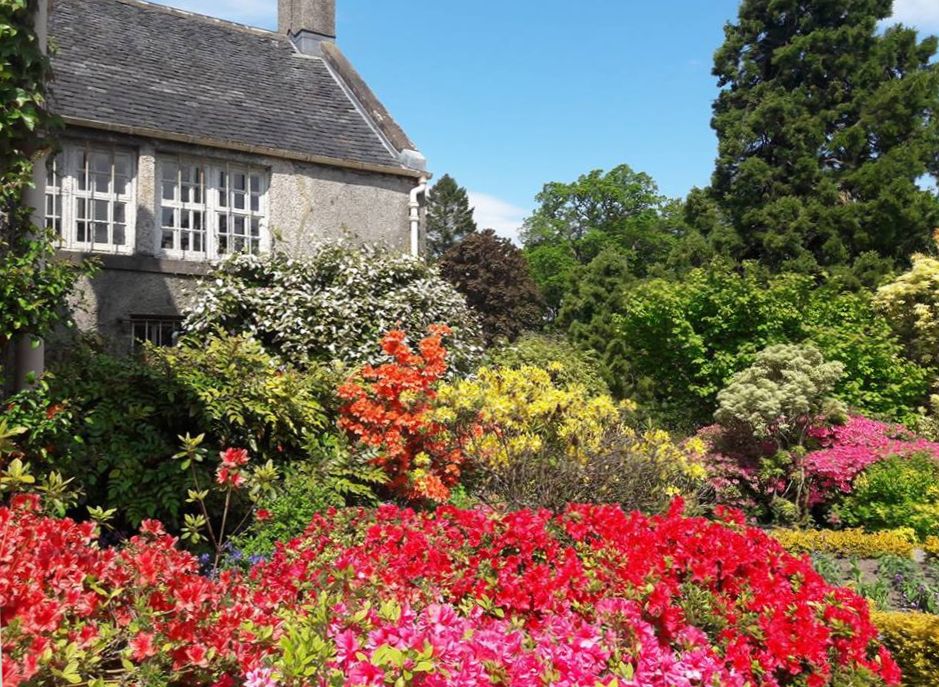  |
Firth of ClydeGeilston Gardens
|
  |
Geilston
House in Geilston Gardens
A category "B" listed building Built for a Glasgow tobacco merchant. |
Pine tree
( Wellingtonia )
in Geilston Gardens |
|
Walled
garden in Geilston Gardens
|
|
Walled
garden in Geilston Gardens
|
|
Geilston
Burn in Geilston Gardens
|
|
Mill pond
in Geilston Gardens
|
|
Waterfall
from Mill Pond
in Geilston Gardens |
|
Mill House
in Geilston Gardens
|
 Geilston Gardens
|
|
Aerial view of
Geilston Gardens
|
|
Firth of
Clyde
from Geilston Gardens |
|
Tudor
style Geilston Hall
in Cardross
A category "C" listed building |
|
Map of
Cardross
|
GEILSTON GARDEN - DESCRIPTION:
Main Road, Cardross, Argyll G82 5HD
Scotland is filled with extraordinary gardens but few can match the enchantment of Geilston, where a window in the potting shed
set into the garden’s high walls opens onto a secret glade where thousands of wildflowers spangle the grass on either side of a tinkling burn.
May is the best time to catch this spectacle, when bluebells and wood anemones stud the ground and the trees above them are opening fresh, green leaves.
The glade is part of the woodland that surrounds Geilston, which is typical of the small estates that sprung up along the Clyde during
the 18th century as their owners grew rich on shipping and trade.
It was at this time too that exotic new plants began to arrive on these shores and the centrepiece of the walled garden
is a 250-year old Wellingtonia ( Sequoiadendron giganteum), which is now 30 metres tall.
This magnificent tree presides over a 40-metre herbaceous border that is just now beginning to get into its stride, filling up with
foliage and the flower buds that will provide a succession of colour throughout the summer.
The three sides of the garden that surround the house are smothered in roses and both here and in front
of the house are parterres created from low hedging which, along with the avenue of trees that line the
driveway, add a period touch to the estate and contrast with areas of contemporary planting.
DELICIOUS EDIBLES
Geilston is home to a huge kitchen garden, which is surrounded by beech hedging and protected by a shelter belt of trees that filter the
winds rushing in from the River Clyde.
The soil here has been cultivated for more than two centuries, so is deep and rich, providing the perfect growing conditions for
carrots, cabbages, lettuces and a whole range of vegetables.
Part of the garden is occupied by a large collection of rhubarb varieties and an orchard, currently smothered in
blossom, provides fruit later in the year.
At the very centre of the garden is a dipping pond that supplies water for the crops and throughout the summer.
Ripe produce is sold from a stall at the entrance gate.
GLORIOUS GLASSHOUSES
At the far end of the walled garden is a restored Mackenzie and Moncur greenhouse, where seedlings and tender plants are
warmed by Victorian pipework, set beneath the cast iron gratings that form the floor.
For more than 30 years, Mackenzie and Moncur, which was established in Edinburgh in 1869, created some of the finest
greenhouses, orangeries and conservatories in the country and many are still in use today.
FUN FQR YOUNG VISITORS
The potting shed, woodlands and secret glade are all appealing to children and there is also a playground and a mini maze to keep young visitors entertained.
The burn is ideal for pond dipping and playing Pooh sticks and there are enough flowers in the long grass to make endless daisy chains.
BLUEBELLS
The bluebells growing at Geilston are our native Hyacinthoides non-scripta. These are distinguished from Spanish bluebells by their
nodding habit and flowers that hang from just one side of the stem. Grown in numbers, they give off the fragrance of hyacinths.
Scotland’s ancient woodlands provide perfect conditions for bluebells, which enjoy dappled shade beneath a light canopy of emerging leaves.
When planting bluebells it is important to buy them from a reputable source which guarantees that they have been cultivated from seed and not dug up from the wild.
DETAILS
Open daily, 10am-5pm
Tickets: £8.50/£6.50
The garden is located at the west end of Cardross on the A814, 18 miles north-west of Glasgow.
 :: Ardmore
Point
Gallery
:: Ardmore
Point
Gallery  :: Helensburgh
Gallery
:: Helensburgh
Gallery 
Glencoe | Ben Nevis | Knoydart | Isle of Skye | Isle of Arran | The West Highland Way
The Eastern Highlands | The Central Highlands | The Southern Highlands | The NW Highlands